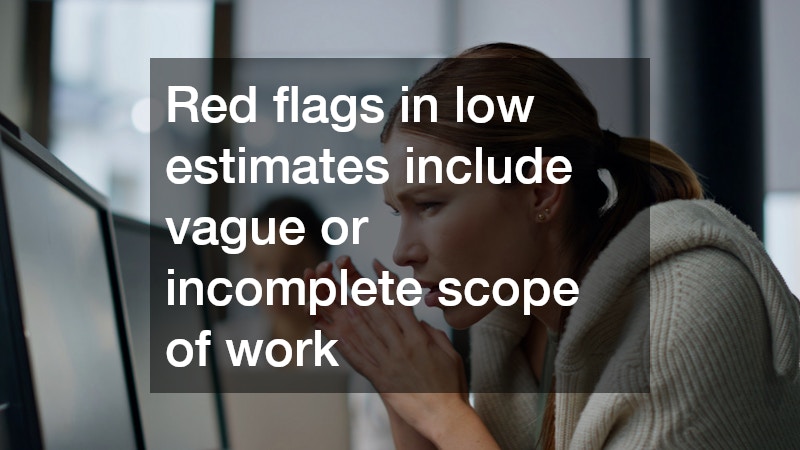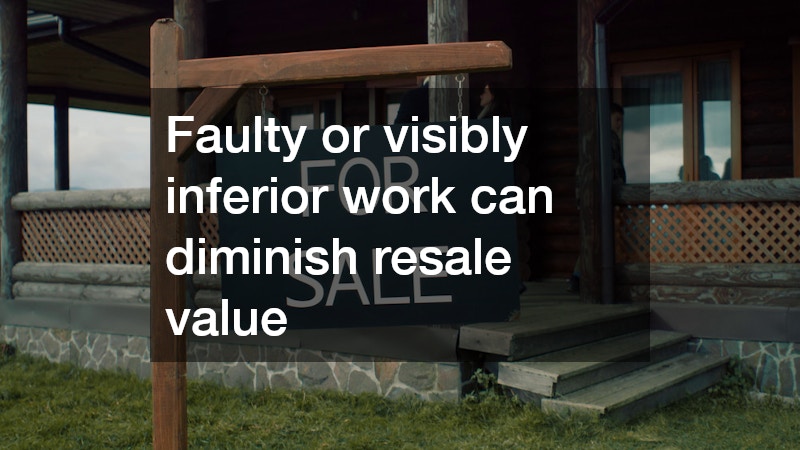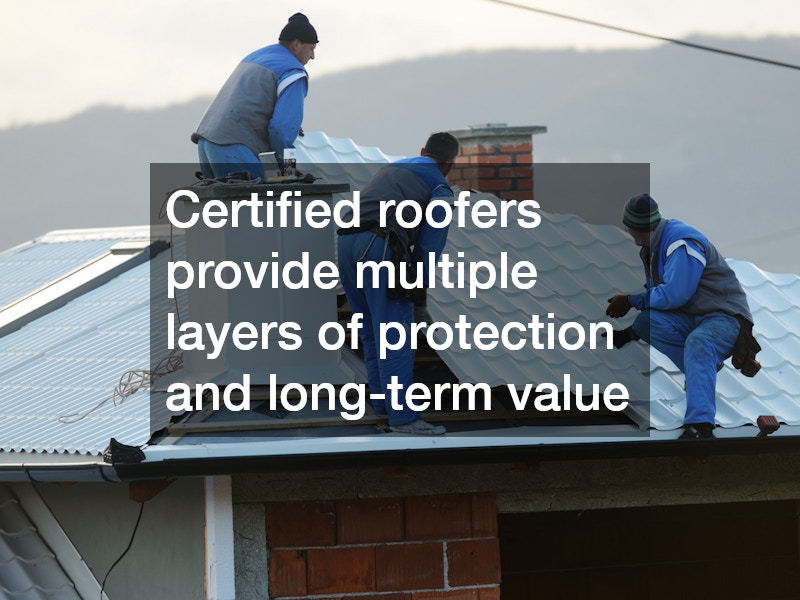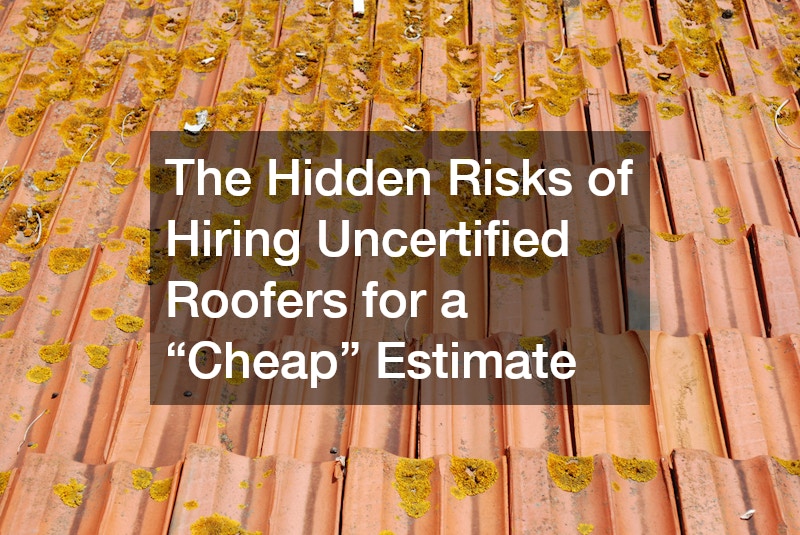-
Cheap roofing estimates from uncertified roofers often hide long-term costs and risks.
-
Certified roofer estimates include high-quality materials, proper installation, and warranty protection.
-
Unlicensed contractors may void manufacturer warranties and insurance coverage.
-
Detailed, written estimates from certified roofers reduce the likelihood of hidden fees or disputes.
-
Verifying licensing, insurance, and references is essential before hiring any roofing contractor.
-
Investing in certified roofing estimates provides peace of mind and long-term cost savings.
Roofing is one of the most critical components of any home, and maintaining a strong, secure roof protects both property value and occupant safety. When a homeowner is faced with a damaged roof or the need for replacement, receiving multiple estimates is a common first step. While a low estimate from an uncertified roofer might seem like a cost-saving opportunity, these cheap quotes often conceal significant risks. Unlicensed contractors frequently cut corners on labor, materials, or safety compliance, which can result in costly repairs, insurance complications, or even voided warranties. In contrast, certified roofer estimates, although sometimes higher, provide a structured approach with proper labor, high-quality materials, and the necessary documentation to ensure long-term protection and peace of mind.
Understanding the differences between certified and uncertified roofing contractors is essential for homeowners. While the lure of a “cheap” estimate is strong, the hidden costs of poor workmanship or regulatory noncompliance often outweigh any initial savings. By carefully evaluating roofing estimates, homeowners can avoid financial, legal, and structural pitfalls while securing a roof that will last for decades.
Why Uncertified Roofers Offer Low Estimates
Uncertified roofers frequently provide low estimates to attract homeowners who may not realize the long-term risks of hiring unlicensed contractors. These low quotes are typically possible because the roofer bypasses several critical expenses required of licensed professionals. Labor may be cheaper due to untrained workers, materials may be substandard, and safety protocols may be ignored—all factors that reduce costs but create serious long-term consequences.
Reasons uncertified roofers can offer low estimates:
-
Reduced labor costs: Workers may lack proper training or certification, increasing the likelihood of errors or incomplete installations.
-
Cheap materials: Low-quality shingles, underlayment, and flashing may be used to minimize expenses, which often leads to premature wear or structural damage.
-
No insurance or bonding: Without liability or workers’ compensation coverage, the homeowner may become financially responsible if accidents or property damage occur.
-
Minimal regulatory compliance: Unlicensed roofers may skip necessary permits, inspections, and building code requirements, which can result in legal or insurance issues.
Red flags in low estimates include:
-
Vague or incomplete scope of work
-
Requests for full payment upfront or cash-only transactions
-
Promises of unusually fast project completion without detailed planning
-
Refusal to provide licensing or insurance documentation
-
Absence of manufacturer-approved product specifications or warranties
By recognizing these warning signs, homeowners can avoid potentially expensive mistakes before accepting a roofing estimate.

Hidden Costs Homeowners May Face After Hiring an Uncertified Roofer
While an uncertified roofer’s estimate may initially appear economical, homeowners frequently discover hidden costs that dramatically exceed the original quote. Subpar workmanship and inferior materials can result in problems ranging from leaks and structural damage to voided warranties and insurance complications.
Potential hidden costs include:
-
Premature roof failure: Improperly installed shingles or underlayment can lead to leaks within months, requiring costly repairs or replacement.
-
Structural damage: Water infiltration can compromise rafters, decking, and insulation, potentially leading to mold growth or weakened structural integrity.
-
Insurance complications: Many insurance policies require proof of licensed, certified installation. If damage occurs due to an uncertified roofer’s work, claims may be denied.
-
Safety hazards: Injuries on-site may fall on the homeowner if the contractor lacks insurance, creating legal and financial exposure.
-
Reduced property value: Faulty or visibly inferior work can diminish resale value and discourage potential buyers.
Summary of Hidden Costs:
-
Replacement of improperly installed shingles, flashing, or underlayment
-
Structural repairs due to water damage
-
Denied insurance claims for storm or water-related damage
-
Increased long-term maintenance and repair costs
-
Legal disputes or financial liability from accidents
-
Decreased home resale value
Considering these hidden costs demonstrates that the initial savings from a cheap estimate may be a false economy.
How Unlicensed Work Can Void Warranties and Insurance
One of the most serious risks of hiring an uncertified roofer is the potential to void warranties and insurance coverage. Most roofing materials are only covered under warranty if installed by licensed professionals. Similarly, insurance policies often require certified installation for claims to be honored.
Detailed considerations:
-
Manufacturer warranties: Certified roofer estimates ensure that materials are installed according to manufacturer specifications. Unlicensed installation may void warranties, leaving the homeowner responsible for material replacement.
-
Insurance claims: Damage from storms, leaks, or other roofing issues may not be covered if the work was performed by an unlicensed contractor. Homeowners may need to pay for costly repairs out-of-pocket.
-
Liability: Injuries or accidents that occur during installation may fall on the homeowner if the contractor is uninsured.
Warranties and Insurance Risks:
-
Manufacturer warranties often require certified installation
-
Insurance claims may be denied if the contractor is unlicensed
-
Homeowners may bear liability for on-site injuries or property damage
-
Professional roofing estimates from licensed contractors typically include labor and material warranties
-
Using certified roofers ensures compliance with building codes, reducing risk of claim denial

Certified vs. Uncertified Roofers: Key Differences
While uncertified roofers may seem cost-effective initially, certified roofers provide multiple layers of protection and long-term value. They are trained, licensed, insured, and often manufacturer-approved, ensuring that professional roofing estimates are comprehensive, reliable, and transparent.
Benefits of certified roofers:
-
Verified credentials: Licensed contractors comply with local regulations and maintain liability and workers’ compensation insurance.
-
High-quality materials: Professional roofing estimates include manufacturer-approved shingles, underlayment, and other components.
-
Safety and compliance: Certified roofers follow proper safety protocols, obtain necessary permits, and ensure work meets building codes.
-
Warranty protection: Labor and materials are usually covered, protecting homeowners from future repair costs.
-
Long-term cost-effectiveness: Though upfront costs may be higher, certified roofing estimates reduce future repair, insurance, and liability risks.
Advantages of Certified Roofing Estimates:
-
Detailed, itemized estimates for labor, materials, and warranties
-
Licensed contractors verified with local authorities
-
High-quality, manufacturer-approved materials
-
Compliance with safety regulations and local building codes
-
Reduced likelihood of costly repairs or insurance claim issues
-
Clear documentation for warranty and insurance purposes
-
Protection against financial liability for on-site accidents

Red Flags to Watch for in Cheap Roofing Estimates
Even if an estimate is within budget, homeowners should be vigilant for warning signs that suggest the roofer is unlicensed or cutting corners. Identifying these red flags can prevent costly mistakes before work begins.
Red flags include:
-
Lack of licensing or insurance documentation
-
No written, itemized estimate with labor, materials, and timelines
-
Pressure to sign contracts or pay large sums upfront
-
Vague descriptions of work, permits, or warranties
-
Refusal to provide references or show completed projects
Bullet Points – Common Warning Signs:
-
Extremely low pricing compared to market averages
-
Absence of manufacturer-approved materials or warranty information
-
Cash-only payment requests or upfront payment demands
-
No timeline or project plan provided
-
Avoids providing professional references or photos of previous work
Steps Homeowners Can Take to Protect Themselves
Taking proactive measures ensures that homeowners select a reputable contractor and secure reliable, certified roofing estimates.
Bullet Points – Protective Measures:
-
Verify licensing and insurance: Confirm the contractor’s credentials with local authorities.
-
Request multiple estimates: Compare at least three certified roofer estimates to gauge fair pricing.
-
Detailed written contract: Ensure it includes materials, labor, warranties, permits, and timelines.
-
Check references and reviews: Speak with previous clients and review project photos.
-
Avoid large upfront payments: Tie payments to project milestones.
-
Confirm compliance with building codes: Ensure necessary permits and inspections are included.
-
Ask about warranties: Verify coverage for both labor and materials, and for how long.
While cheap roofing estimates from uncertified contractors may seem tempting, they carry hidden risks that can far outweigh the initial savings. Poor materials, improper installation, and lack of licensing can lead to leaks, structural damage, insurance claim denials, and voided warranties. Certified roofer estimates, though sometimes higher, provide detailed itemization, high-quality materials, proper permits, and warranty coverage.
Homeowners should prioritize verified credentials, multiple estimates, written contracts, references, and long-term protection over short-term savings. By investing in professional roofing estimates from licensed contractors, homeowners safeguard their property, finances, and peace of mind.
| Feature / Factor | Cheap Uncertified Roofer Estimates | Certified Roofer Estimates |
|---|---|---|
| Cost | Low upfront cost but may incur hidden expenses | Higher upfront cost but more predictable and long-term value |
| Materials | Often low-quality or substandard | Manufacturer-approved, high-quality materials |
| Workmanship | Risk of poor or rushed installation | Professional, trained, and code-compliant installation |
| Warranty Coverage | Usually none; manufacturer warranties may be void | Includes labor and material warranties; maintains manufacturer coverage |
| Insurance / Liability | Typically uninsured; homeowner liable for accidents or damage | Fully insured with liability and workers’ compensation coverage |
| Safety Compliance | Often minimal or ignored | Adheres to all safety standards and regulations |
| Permits & Codes | May skip required permits or inspections | Ensures all work meets local building codes |
| Long-term Costs | High potential for repairs, structural damage, and insurance issues | Lower long-term costs due to quality installation and warranty protection |
| References / Accountability | Often lacks references or verifiable past work | Provides references, past project portfolio, and professional accountability |
| Peace of Mind | Low – risk of failures and hidden costs | High – reliable work, warranties, and protection for the homeowner |
